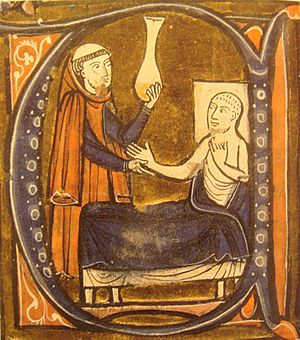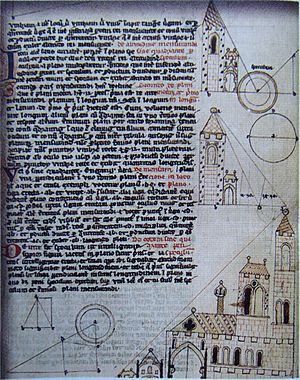Gerard of Cremona facts for kids

Gerard of Cremona (born around 1114 – died 1187) was an Italian translator. He translated many important science books from Arabic into Latin. He worked in Toledo, which was part of the Kingdom of Castile at the time.
Gerard found many Arabic books in the libraries of Toledo. Some of these books were originally written in Greek. Even though they were well known in places like Byzantine Constantinople and Greece, they were not available in Western Europe in Greek or Latin. Gerard of Cremona was a very important translator. He was part of the Toledo School of Translators. These translators helped bring ancient Greek and Arab knowledge about astronomy, medicine, and other sciences to Europe. One of Gerard's most famous translations was Ptolemy's Almagest. He translated it from Arabic texts he found in Toledo.
It can be a bit confusing, but there seem to have been two translators named Gerard of Cremona. One worked in the 12th century and focused on astronomy and science. The other worked in the 13th century and focused on medical books.
Contents
Gerard's Early Life and Move to Toledo
Gerard was born in Cremona, a city in northern Italy. He wasn't happy with what his teachers in Italy were teaching him. So, Gerard decided to travel to Toledo. He wanted to learn Arabic so he could read Ptolemy's Almagest. This book was very famous among scholars, but it hadn't been translated into Latin yet. We don't know exactly when Gerard went to Castile, but it was no later than 1144.
Toledo was a special place. It used to be a big city in the Caliphate of Cordoba. It was also a major center for learning. In 1085, Alfonso VI of Castile conquered Toledo from the Moors. This made it safe for a Catholic like Gerard to live and work there. Toledo remained a city where different cultures lived together. Its rulers protected the large Jewish and Muslim communities. This helped keep Toledo an important center for Arab and Hebrew culture. The city had many libraries and old manuscripts. It was one of the few places in medieval Europe where a Christian could learn about Arabic language and culture. Gerard spent the rest of his life in Toledo, translating Arabic science books into Latin.
Important Books Gerard Translated

Gerard of Cremona's Latin translation of Ptolemy's Almagest (done around 1175) was the most well-known version in Western Europe before the Renaissance. This book was very important for understanding the stars and planets.
Gerard also prepared the Tables of Toledo for Latin readers. This was a collection of astronomical data. It was the most accurate information about the stars and planets available in Europe at that time. Part of these Tables came from Al-Zarqali, a mathematician and astronomer from Cordoba.
Al-Farabi, a famous Islamic scholar, wrote many books. One of his books, Kitab lhsa al Ulum, talked about how sciences are grouped and their basic rules. Gerard translated this book as De scientiis (On the Sciences).
Gerard also translated Euclid’s Geometry and Alfraganus's Elements of Astronomy. He even wrote his own books on algebra, arithmetic, and astrology. In his astrology book, he calculated locations from both Cremona and Toledo.
In total, Gerard of Cremona translated 87 books from Arabic. These included Greek works like Ptolemy's Almagest and Euclid's Elements of Geometry. He also translated Arabic works like al-Khwarizmi's On Algebra and Almucabala and books by al-Razi (also known as Rhazes). Gerard of Cremona also helped create many anatomical terms in Latin.
Another Gerard of Cremona?
Some books that are said to be by Gerard of Cremona might actually be the work of a different person. This other translator was also called Gerard Cremonensis, or Gerard de Sabloneta. He worked in the 13th century, after the first Gerard. This later Gerard mostly translated medical books, not astronomy books. Because they had similar names and worked in the same field, people often got them confused. Some of his translations were of works by Avicenna, a famous doctor. These translations were supposedly made for Emperor Frederick II.
Other books linked to this "Second Gerard" include Theoria or Theorica planetarum (about planets). He also translated versions of Avicenna’s Canon of Medicine and Almansor by al-Razi (Rhazes). The Canon of Medicine became a very important medical book in Europe.
See also
 In Spanish: Gerardo de Cremona para niños
In Spanish: Gerardo de Cremona para niños


